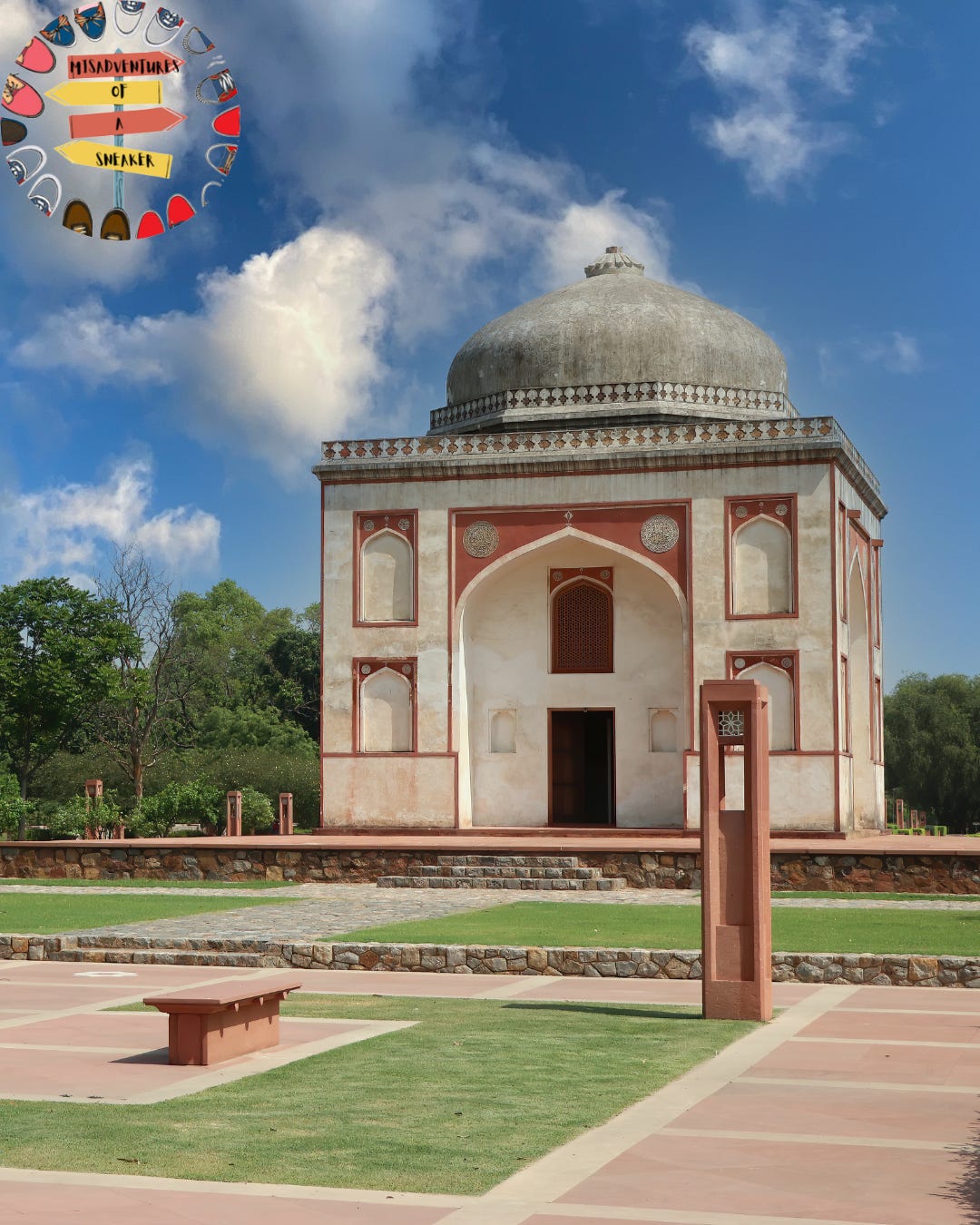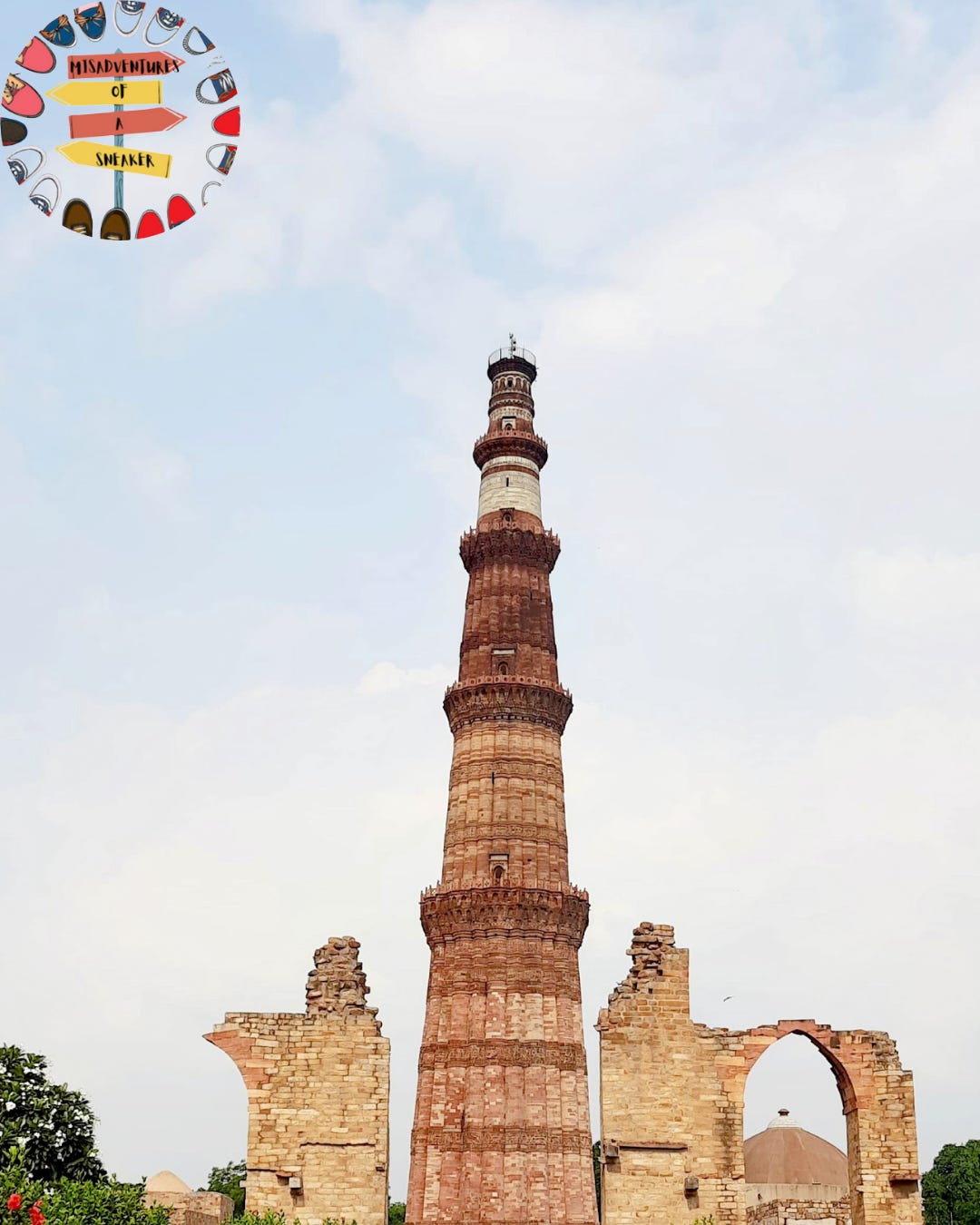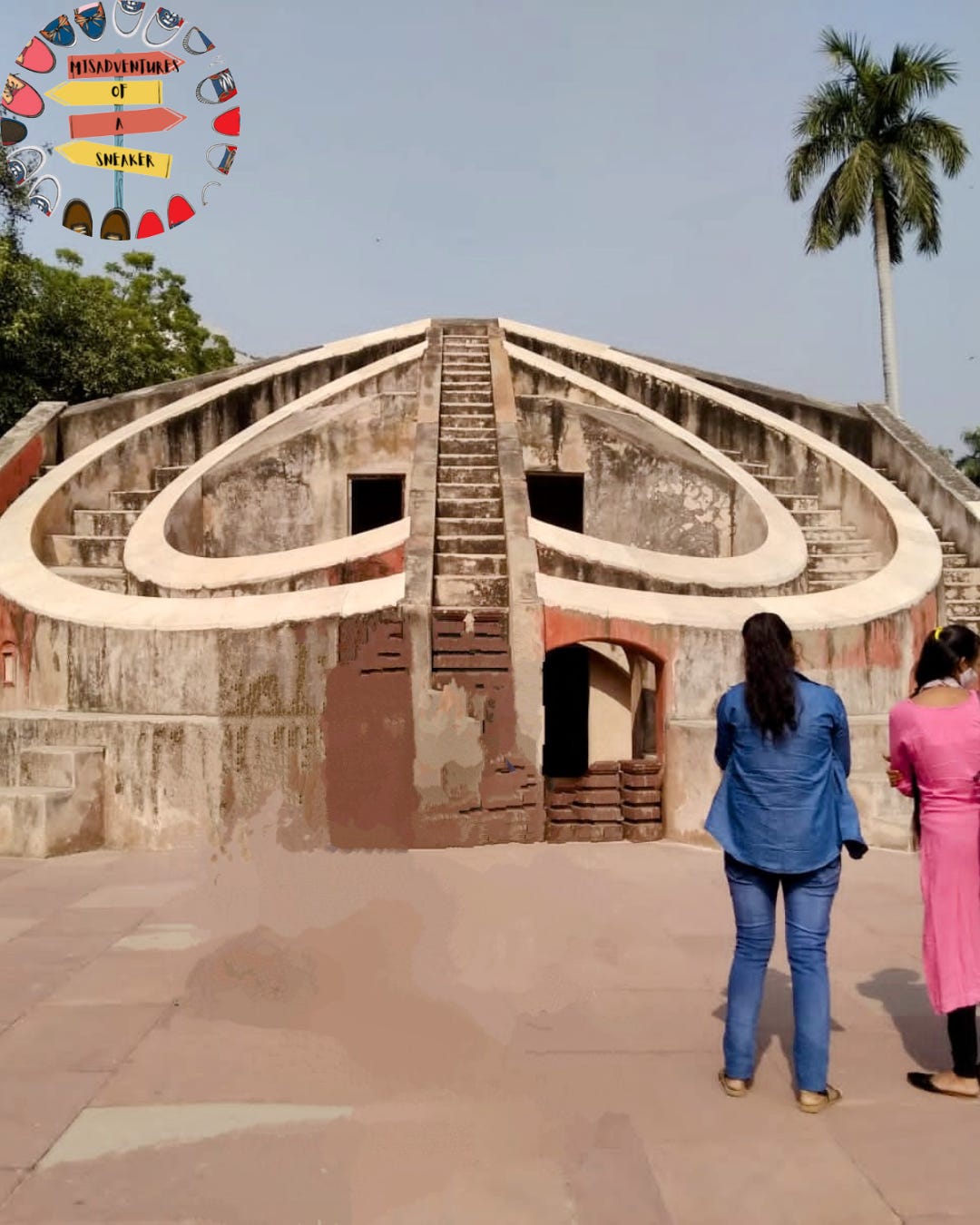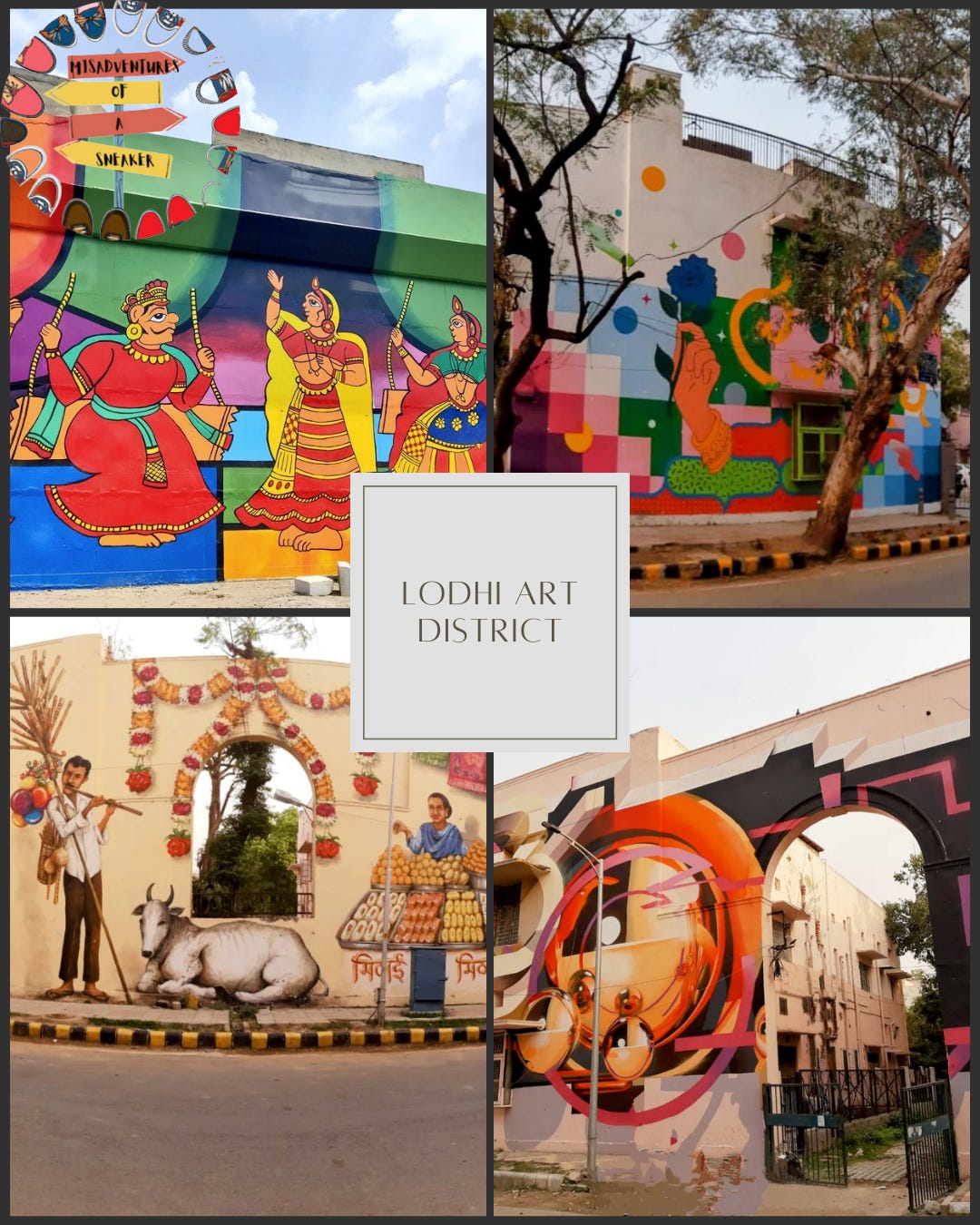From Qutub to Quirk: A Modern Odyssey in Delhi
Experiencing the cultural crossroads and the diversity in Delhi with Haritha Vijay VL
As Prasoon Joshi quotes in his song, Delhi-6, “Yeh shehar nahi mehfil hai.. Yeh dilli hai mere yaar”
Step into Delhi, or as we fondly call it, the 'dil walon ka sheher' (city of the warm-hearted), and get ready for an epic hug! This place is like a cool mixtape of rich history and lively chaos, offering something for everyone, no matter your vibe or age. Give it a whirl for a few days, and we promise, you might just find yourself smitten with the city—even if the air tries to play the drama queen. 😷
When Delhi pops into my head, it's basically a Haritha flashback! The city screams "home" thanks to the epic dose of love from Haritha and her fam. Today, brace yourselves, because she’s our guide through the galis and mohallas of Delhi – and trust me, it's gonna be a wild ride!
Haritha, the calligraphy queen and plant whisperer, boasts the world's most envy-worthy handwriting. Seriously, it's like fonts are jealous of her! Living in Delhi, she's basically the warmest hug in human form. When she's not lost in her world of stationary and plants, you'll catch her studying so intensely that you might need to give her a little shake to bring her back to Earth.
After spending what feels like a gazillion years in Delhi, Haritha's practically the tour guide extraordinaire. Heritage walks, café tours—she's done it all. It's like having your own personal Delhi encyclopaedia, with a side of her infectious warmth.
Delhi is a small city, but like Haritha says, it’s unbelievable how such a small city can house so many different monuments, museums, gates, forts, experiences and so much more. So taking you through a tour of the city will be a task, but that’s what we’re here for 🙂 Haritha and team of Misadventures of a Sneaker chalked out a route for you to start the exploring. So let’s get going..
Let’s take you first to the Hazrat Nizamuddin Area. My first time here totally blew me away with its lively crowd and a whole different vibe from what I'm used to. It's like the go-to spot for soulful Sufi stuff, with the dargah that pulls in people from all walks of faith. Big names like Hazrat Nizamuddin Auliya, poet maestro Amir Khusrau, Jahanara Begum (Shah Jahan's daughter), Mirza Ghalib, the Urdu poetry legend, and Inayat Khan, who spread Sufism way beyond India, all rest here.
To really soak in the Nizamuddin scene, you've gotta dive into the qawwali tradition, especially with the vibes of the legendary Nusrat Fateh Ali Khan still hanging around. Catch the magic go down at the Nizamuddin Dargah on Thursdays, with qawwali sessions rocking the place from 6:00 PM to 7:30 PM and 9:00 PM to 10:30 PM. Picture an open courtyard filled with soul-stirring music that'll take you to a whole different spiritual level. It's like a divine connection in the heart of the chaos! (Closest Metro Station: Sarai Kale Khan, pink line)
Pro tip: Kindly be aware that it is customary to cover your head within the Dargah complex; therefore, it is advisable to carry a scarf or handkerchief. Additionally, several areas necessitate walking barefoot, so it is recommended to wear shoes that can be easily removed and comfortably worn.
This area has my go-to spot - the Humayun's Tomb - a UNESCO World Heritage building and a stunning example of Mughal architecture. It's unique as one of the few monuments commissioned by a woman, Humayun's widow, Bega Begum. Designed by a Persian architect, it introduced innovations like the char-bagh, a Quran-inspired garden setting. This monumental scale set the tone for future Mughal projects, including the Taj Mahal and Rashtrapati Bhavan.
Known as the 'dormitory of the Mughals,' over 150 family members rest in its chambers. The tomb contributes to the densest collection of medieval Islamic structures in India.
My top pick in the city, I adore just chilling in Humayun's Tomb garden—reading, painting, soaking in its beauty. It's an absolute gem and a must-visit!
Other notable structures around the area also includes Chausath Khamba (a tomb with sixty-four pillars) and the tomb of Atgah Khan. We recommend taking a historical walk there for the best historical story diving experience.
Another beloved spot nearby for me is Sunder Nursery1, formerly known as Azim Bagh during the Mughal era. Established in the 20th century to cultivate plants for New Delhi, this place is a delightful haven. Whether you're strolling, enjoying a quiet read, or simply exploring the diverse array of plants and trees, it offers a perfect escape. Sunder Nursery becomes an idyllic spot for picnics during Delhi winters. Stay updated on their events by following their Instagram page.
(Closest Metro Station to Humayun’s Tomb and Sunder nursery: Jor Bagh, yellow line or JLN Stadium, violet line)
If you find yourself with some free time, I strongly urge you to visit Khan Market. Explore the treasures of some of the country's oldest bookstores like Faqir-Chand Bookstores or Bahrisons Bookstores. And the best part? There's a plethora of cafes to choose from, providing the perfect setting to dive into the incredible books you just picked up! (Closest Metro Station: Khan Market, violet line)
Pro tip: Explore the Mehrauli area and do keep an eye our for the large Jhandewalan Hanuman statue which can be seen from the Yellow Line metro.
Mehrauli, the oldest continuously inhabited region in Delhi, is home to the Qutb Complex. And needless to say, the Qutub Minar is the main majestic attraction here. A UNESCO World Heritage Site from the early 13th century, the Qutub Minar is one of the tallest minarets in the world. As evening falls, Qutub Minar lights up, creating a breath-taking sight that might just make people stop and stare, according to Haritha. It's textbook famous, but the real-life experience is beyond perfection!
Don't miss the Quwwat-ul-Islam Mosque, the first mosque built in Delhi after the twelfth-century Islamic conquest is an Indo-Muslin masterpiece. Wander through the complex to discover Iltutmish’s Tomb, the magnificent Alai Darwaza, and Alauddin’s Madrasa. Although Alauddin Khalji's ambitious Alai Minar project was abandoned, the remnants, like the captivating Iron Pillar and tombs of Iltutmish and Alauddin Khilji, remain. Take your time exploring the intricate details and snap some amazing pictures—it's the perfect spot for it! (Closest Metro Station: Qutub Minar, yellow line)
Near the Qutub Minar complex lies the Mehrauli Archaeological Park—a must-visit on your Delhi trip. Its enchanting mix of history, intricate architecture, and lush landscapes will leave you mesmerized.
As you enter the park, Balban’s Tomb catches your eye, a massive beauty with a striking Roman Arch. Further along, you'll spot Metcalfe’s Dome, designed for an optimal view of the Qutub Minar. Rajon Ki Baoli, a stepwell, is a highlight, boasting beautiful architecture with arched walls and intricate stonework.
In this mix of wonders, the tomb and mosque of Jamali Kamali stand out with a captivating story. Jamali, a renowned poet from a merchant family, found eternal rest in the tomb alongside Kamali after his death in 1535. Legend has it that the two were deeply in love, making them one of the oldest examples of queer love in the books. Personally, I'm all about those detailed paintings and Quranic inscriptions on the tomb!
Pro tip: There are many cafes nearby in case you want to take a break from all the walking! The park opens at 5:00 AM and closes at 6:30 PM, making it perfect for an early morning stroll or capturing some sundowner photos. To reach Mehrauli Archaeological Park, hop off at Qutub Minar metro station (if using the metro) on the yellow line, and grab an auto to the park—no entry charges apply.
Now as Haritha wisely puts it, "If you haven't seen the Lotus Temple in Delhi, have you really seen anything?" Shaped like a lotus flower, this is the last of seven Bahai temples globally, completed in 1986 and nestled in lush green gardens.
Crafted from pure white marble, the architect chose the lotus as a universal symbol. It welcomes followers of Hinduism, Buddhism, Jainism, Islam, or any faith to visit, pray, or meditate.
Surrounded by blooming petals and nine-lit pools, it's a spectacle at dusk. A simple stroll around the vast campus brings a sense of calm to my mind! (Closest Metro Station: Kalkaji Mandir, violet and magenta lines)
After the Lotus Temple adventure, hop on the metro and make your way to Bangla Sahib Gurudwara in Connaught Place. During our podcast recording, all three of us were on the same page—this place is a Delhi gem.
Bangla Sahib Gurudwara is the cream of the crop when it comes to Sikh places of worship in Delhi. Initially established as a small shrine in 1783 to honor the eighth Sikh Guru, Guru Har Krishan, this gurdwara has a unique touch. It sits on the sacred ground where Guru Hari Krishan performed a small miracle, distributing sanctified water to the sick. To this day, people consider the gurdwara's pools, sarovar, as holy water with miraculous healing properties.
Formerly known as Jaisinghpura, this beautiful place was initially a bungalow belonging to Raja Jai Singh of Amer. Sikh General Sardar Baghel Singh transformed it into a shrine in 1783, a gift from Raja Jai Singh. Despite the bustling crowds, a serene calmness envelops the Gurudwara. The chaos of traffic outside somehow fades away, leaving you with a tranquil oasis amidst the urban hustle and bustle.
Our strong recommendation: Do not miss the langar and the khada prasad at the Gurudwara. Of course, if you're up for it, sign up for some sewa (volunteer work) too!
(Closest Metro Station: Rajiv Chowk, yellow line)
When you're hanging out in CP, make sure to swing by the National Gallery of Modern Art—it's my absolute fav! A must-visit for art lovers! This place is a treasure trove of modern and contemporary art, spanning from the mid-18th century to today. The collection is housed in Jaipur House, the former palace of the Maharaja of Jaipur—talk about royal vibes! The lush lawns and courtyards play host to a charming sculpture garden too. Oh, and don't miss the art shop for some top-notch prints!
Bonus Tip: If you're a sucker for astronomy and history, make sure to swing by Jantar Mantar in CP as well!
Now we head to the Jama Masjid, India's second-largest mosque, showcasing impressive Mughal architecture. Perched more than 30 steps above the street, it offers a commanding view of the city, including a glimpse of the Red Fort. Also, known as Masjid-i Jahān Numā, meaning 'world-reflecting mosque,' it faces Mecca and boasts an enormous courtyard that can accommodate 25,000 people. The prayer hall entrances feature beautiful calligraphic inscriptions in Persian. (Closest Metro Station: Jama Masjid, violet line)
The Jama Masjid is right in the middle of Chandni Chowk, so while you are there, indulge in the best’est kebabs and meat delicacies. It’s surely a meat-lovers heaven. And when you’re tired, you have the most refreshing beverage, the sherbet-e-mohabbat (most gorgeous sounding name too)!
Also all vegetarians, don’t feel dejected. Chandni Chowk has a world-famous (or at least we feel so) parathe-wali-gali. Head over there and go crazy!
Pro tip: Always come to this area when you’re ravenously hungry 🤣
Venturing from the delightful chaos of Chandni Chowk, our next stop is the iconic Red Fort, another masterpiece by Shah Jahan. Haritha drops a historical bomb that left our jaws on the floor—turns out, the Red Fort was originally not so red! Forget the red sandstones we all thought it was built with; it started life in a pristine shade of limestone. Whaaaat!?
Originally known as "qila-e-mubaraak" or the blessed fort, this colossal structure has quite the story to tell. Every Independence Day since 1947, it hosts the grand spectacle of the national flag unfurling and a prime ministerial address from its imposing ramparts. (Closest Metro Station: Lal Quila, violet line)
Dive into the historical rabbit hole with the archaeological and mutiny museum, along with quintessential fort features like Diwan-i-Khaas, Diwan-i-Aam, and a Rang Mahal. Let's not forget the poetic embrace with Amir Khusro's quote on the wall: "If there’s a heaven on earth, it’s here, it’s here, it’s here."
But, fair warning, navigating this structure is no joke. Plan for a solid 2-3 hours, and brace yourself for hidden museums and royal palaces tucked away inside.
Nestled between Safdurjung’s Tomb and Khan Market in south Delhi, Lodi Garden is a historically rich garden, adorned with enchanting monuments from the Sayyid, Lodi, and Mughal dynasties. Picture this: meandering paths, jogging tracks shaded by ancient trees, and bursts of colors from vibrant shrubs and flowers—a serene nod to the city's rich history. (Closest Metro Station: Jor Bagh, yellow line)
Whether you're on a family outing or in need of some peaceful nature time, Lodi Gardens has your back. And oh, the sunset—it's practically a painting in the sky! Amidst the lush greenery, you'll find impressive structures like the tomb of Sikandar Lodi, the Tomb of Muhammed Shah Sayyid, Bada Gumbad, and more. Take it slow, stroll through the green haven, and let history unfold around you.
Haritha's top tip: Pack a cozy picnic, get those Instagram-worthy shots, and don't forget to shower some love on the adorable doggos of Lodi—trust her, there are plenty of cute furballs waiting to steal your heart!
Lodhi Colony, the final British-era housing estate in Delhi, boasts iconic architecture steeped in history. Since 2015, St+Art India Foundation has transformed it into India's first art district, featuring 50+ murals by global street artists on homes, tree-lined streets—it's perfect for an afternoon stroll. From everyday locals to international visitors, this vibrant canvas attracts everyone.
Haritha's city exploration hack: Roam through neighbourhoods, capturing stunning pictures against the mural backdrops or simply bask in the beauty of the artworks. Finding your way can be a bit tricky, but starting at Meherchand Market is a solid beginning. Look for ‘Lodhi art district’ on google maps and then explore away to glory.
Additional experiences that Haritha and our team shared on the podcast and listing here - lots of more details on this is there on the podcast:
Theatre experience at the India Habitat Center. (Closest Metro Station: Jor Bagh, yellow line)
Hauz Khas for the best places to chill and explore the night life. (Closest Metro Station: Hauz Khas, yellow and magenta line)
Visit India Gate and have an ice-cream there: India Gate, where 84,000 soldiers are remembered for their sacrifice in the First World War, is my go-to spot for a dose of patriotism and some unintentional Bollywood drama—hello "Rang De Basanti" vibes! And let's not forget the essential part of the experience: enjoying an ice cream, because nothing says proper Delhi feels like a sweet treat at this iconic memorial! (Closest Metro Station: Central Secretariat, yellow line)
Haritha insists that a visit to the Akshardham temple is a must. Dedicated to Bhagwan Swaminarayan and various Hindu deities, the intricately carved Akshardham Mandir stands as a testament to spiritual beauty. Haritha encourages a visit, not only for the spiritual vibes but also for the breath-taking light and water show in the evening—worth every penny! (Closest Metro Station: Akshardham, blue line)
Markets: Worry not, we won't leave you hanging without spilling all the deets on Delhi's shopping extravaganza!
Shopping in Delhi is an absolute thrill, especially when you dive into the bustling markets of Janpath, Sarojini Nagar, and Palika Bazar. Here, the art of negotiation turns into a necessary skill, and trust me, it's a bit of an entertaining sport! Mastering the bargaining game is your ticket to scoring fantastic deals on everything, be it clothing, accessories, trinkets, home decor—you name it. The fashion scene is always on point and trendy, whether it's an original, second, or third copy. Street shopping in New Delhi is truly an adventure in style, budget, and the pure joy of a good bargain.
P.S: Personally, I've found the best anime and K-pop merch at Delhi Haat Market, and the prices were unbeatable!
Book markets
Khan market: Dive into an epic book shopping spree amidst cozy cafes for the perfect reading nook. (Closest Metro Station: Khan Market, violet line)
Sunday Mahila market: If you find yourself in Delhi on a Sunday and you're a bookworm, make a beeline for this market. Immerse yourself in the craziest and ultimate book haven, where sellers offer old books for as low as 15 rupees! The market runs from 8 am to 6 pm. (Closest Metro Station: Delhi Gate, violet line)
Connaught Place (Closest Metro Station: Rajiv Chowk, yellow line)
Branded shops in CP
Janpath
Palika Bazaar
Dilli Haat (Closest Metro Station: INA Delhi Haat, yellow line)
Majnu ka Tilla - for everything Tibetan and Korean (Closest Metro Station: Vidhan Sabha, yellow line)
Food recommendations:
Parathe wali gali in Chandni Chowk
Majnu ka Tilla for the best Tibetan and Korean cuisine. Many budget cafes. Laphing and Thukpa are a must try!
Momos are the national food of Delhi 🤣 So have it in every area you get it! Remember you are in Delhi, momos come with spicy chutney and mayonnaise here!
Chole Kulcha - another national food of Delhi - so have it from anywhere
Lane opposite Jama Masjid
Karim’s - known for its legendary butter chicken and biryani
Al Jawahar - It is so popular that Jawaharlal Nehru is known to have visited this place
Explore and eat the different variety of breads (Naans/kulchas/rotis and other bread varieties) that this area is famous for
Big Chill Café
Kunzum Travel Café - Hauz Khas Village
Outside the Qutub Complex (in Mehrauli) you have a lot of rolls - yum!
As we wrap the episode on Delhi, Haritha insists that there are still so many more places and experiences to talk about which might take multiple podcast episodes, or maybe a time machine to cover comprehensively. Haritha also describes how she always felt history somehow connects the cities like Ahmedabad, Delhi, and Hyderabad. For her, these cities will always feel like home away from home.
So, the next time you're in a new city, don't just skim the surface. Take a pause, soak in the shared history, tread the heritage walk paths, wander the maze of narrow lanes, get lost in bustling markets, and, of course, savor the street eats.
Sunder Nursery on Instagram
A suggested itinerary for your trip to Delhi:
Day 1:
Explore the Nizamuddin area:
Nizamuddin dargah
Safdarjung
Humayun’s tomb
Sunder nursery
Head to the Lodhi art district in the afternoon
Explore the Lodhi garden complex and all the monuments there. Relax in the garden too
If you have time, head to the Khan market for great shopping
Day 2:
Start your day with Lotus temple
Head towards the central area and go to the Bangla Saheb Gurudwara
Explore the Modern Art museum at CP
Chill in one of the cafes in CP
Head shopping to Janpath or Palika bazar
Go to the Qutub minar complex in the late afternoon and stay there till post sunset to see the place light up
Day 3:
Start the day with Jama masjid
Explore the food scenes in the lane opposite Jama Masjid or in the parathe wali gali of Chandni Chowk
Optional, take a professional heritage walk through Shahjahanabad
Head to Red Fort and explore the entire fort over the next several hours
Day 4: Explore whatever you missed out in the earlier days
In the evening, go to Akshardham - the light and sound show here is serene and lovely




















